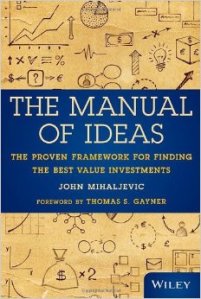In 140 characters or less:
An excellent and detailed review of 9 of the most popular value investing styles. Why they work, and how to apply them.
Why you should read it:
While there are many investing books available to help beginners there are precious few that add value for those that have already mastered the basics. The Manual of Ideas steps in to the breech, providing a concise survey of the best value investing has to offer. It is written with the intermediate-advanced investor in mind.
The bulk of the book is 9 chapters, each reviewing a different value investing approach and asking the same questions of each. Why do they work? How can they be used and misused? How can we find these type of opportunities? How should we analyse these opportunities once they are found?
The value investing approaches covered:
- Deep Value: Ben Graham Style Bargains
- Sum-of-the-Parts Value: Investing in Companies with Excess or Hidden Assets
- Greenblatt's Magic Search for Good and Cheap stocks
- Jockey Stocks: Making Money alongside Great Managers
- Follow the Leaders: Finding Opportunity in Superinvestor Portfolios
- Small Stocks, Big Returns? The Opportunity in Underfollowed Small- and Micro-Caps
- Special Situations: Uncovering Opportunity ini Event-Driven Investments
- Equity Stubs: Investing (or Speculating?) in Leveraged Companies
- International Value Investments: Searching for Value beyond Home Country Borders
Despite being less than 300 pages, The Manual of Ideas took me a surprisingly long time to finish. The content wasn't particularly tough, but it was so jam-packed with value and thoughtful insights that I found myself re-reading paragraphs several times over.
Key lessons:
I endeavor to follow Farnam Street's (and Mortimer Adler's) guide 'How to Read a Book' and scribble down my key takeaways as I read a book. The Manual of Ideas makes this even easier by breaking down 10 key takeaways for each chapter. Rather than recreating that exhaustive list I will just point out a few key ideas that stuck out for me personally. There are literally hundreds more great insights that could have made this list.
#1: Cast yourself as the world's chief capital allocator
This was my biggest take away from the book. If you can stick to this, you avoid most of the pitfalls of the market, and are never holding a poor investment while in search of a greater fool
"While most investors do have a negligible impact on the overall market, the accompanying small fish mind-set does not lend itself to successful investing. Even when I invested a timy amount of money, I found it helpful to adopt the mind-set of chief capital allocator. I imagined my role as distributing the world's financial capital to activities that would generate the highest returns on capital."
"If I directed the allocation of the world's capital, I would not be able to rely on the market to bail me out of bad decisions. The greater fool theory of someone buying my shares at a higher price breaks down if the buck stops with me. Successful long-term investors believe their return will come from the investee company's return on equity rather than from sales of stock"
#2: Your process must be tailored to the value investment strategy you are pursuing.
This is both obvious and easily overlooked. All too often investors will talk themselves out of a deep value opportunity because the business is in turmoil. Or out of a fast growing company because it has a relatively higher valuation.
The core premise of The Manual of Ideas is that a distinct investment process, screening tools, and analytical framework must be used for each of the 9 investment approaches discussed. Mixing and matching tools between different frameworks is a recipe for disaster.
Case in point, a business with high returns on capital provides the investor no advantage if it pays out all of its earnings as dividends.
"The return on capital earned by the business is irrelevant when the payout ratio is 100%. As the payout ratio declines, the economics of the business becomes increasingly important."
#3: Capital light businesses are the most easily threatened
"When something other than capital employed drives the profits of a business, that something can change quite easily unless the business has a sustainable moat. Businesses with low capital intensity may be more likely to exhibit winner-take-all dynamics, as capital is not a barrier to scale. Consider how quickly Apply crushed well-established companies Nokia, Research in Motion, and even Sony."
#4: Investing might be a zero-sum game, but investors decide the average return
The idea that investing is a zero-sum game gets a lot of airtime. But this ignores the role that investors, as capital allocators, have on the average return.
"Many investors [have a] correct but incomplete view that public market investing is a zero-sum game. While not all investors can earn above-average returns, the average return is far from predetermined. If investors consistently made terrible decisions, for instance by investing only in money-losing Internet companies, there might be just as many relative underperformers and outperformers as there are today, but the market return would be considerably lower."
The last word:
On top of these key lessons there were literally hundreds of excellent insights in to the best way to pursue the 9 strategies. I am sure this will not be the last book that we see from John Mihaljevic and I look forward to the next.








